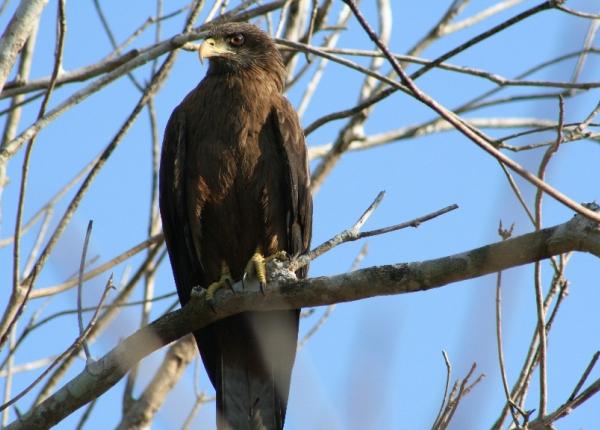Did You Know?
- The Yellow-billed Kite is still considered a sub-species of the Black Kite (Milvus migrans) found throughout Eurasia. However, genetic studies suggest that it may be a separate species, but it has not yet been accepted as such by many authorities.
- Researchers in Botswana observed Yellow-billed Kites fishing by grabbing fish from the surface of the water and consuming these fish while in flight.
How The Peregrine Fund is Helping
Though The Peregrine Fund doesn't work directly with Yellow-billed Kite, our efforts in scientific research, habitat conservation, education, and community development help conserve birds of prey around the world. We also supply literature to researchers from our avian research library, which helps scientists around the world gather and share important information on raptor conservation. Our support of the Global Raptor Information Network gives raptor researchers tools to more efficiently conduct their own studies while contributing to a global program. It also provides citizen scientists a way to participate in raptor science and conservation.
Where They Live
The Yellow-billed Kite is found throughout much of sub-Saharan Africa, in nearly all types of habitats including forests, wetlands, savannas, and to a lesser extent, arid environments. The Black Kite is found in Europe and Asia.
What They Eat
These kites have a varied diet and will consume insects, crustacea, amphibians as well as small mammals and other vertebrates, and will also scavenge for carrion, including dead fish floating in the water or fish remains discarded by fishermen.
Nests, Eggs, and Young
Yellow-billed Kites collect dry stick nests from nearby trees with which to build their nests. Both the male and female work together to construct the nest, which is placed on average around 9 meters above the ground in trees, such as Tamarinds. In a study conducted in Madagascar, researchers also noted that the birds added some other interesting materials to their nests, which they collected from the ground. Some materials they used include rags, mud, plastic bags, and even dog feces and cow dung!
Yellow-billed Kites are very protective of the nest, and will chase after and attack any intruders.
Yellow-billed Kite and the World Center for Birds of Prey
The World Center for Birds of Prey offers fun ways to learn about birds of prey. Interactive activities, tours, interesting videos and a children's room with activities from coloring sheets to quizzes to costumes. There is also a touch table with owl feathers and other natural objects available for exploration. We also have several ambassador birds on hand that include eagles, owls, condors, hawks, and falcons.
References:
Andriamalala, T., Rene de Roland, L.A., Rakotondratsima, M., Razafimanjato, G. and Thorstrom, R., 2013. Nest characteristics of Yellow-billed Kites Milvus aegyptius in the Manambolomaty Lakes Complex, western Madagascar. Ostrich, 84(1), pp.79-84.
Harrison, J.A. and Cherry, M., 1997. The atlas of southern African birds. Nature, 389(6646),
Humphrey, G. and Saffarek, L., 2013. Evidence of Yellow-billed Kites Milvus eagyptius fishing during the barbel run in the Okavango pan-handle, Botswana. Biodiversity Observations, pp.27-30.









